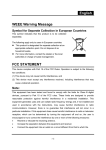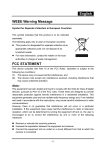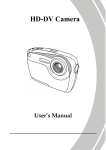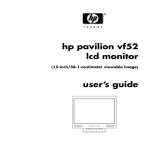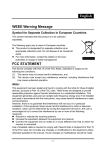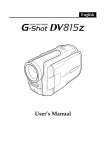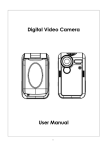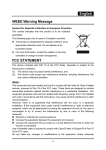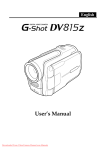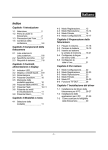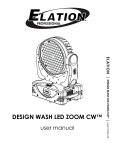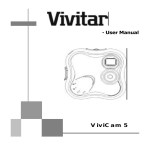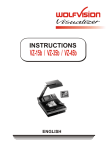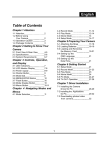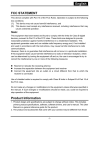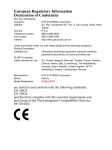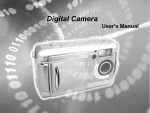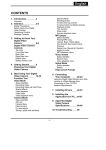Download English FCC STATEMENT
Transcript
English FCC STATEMENT This device complies with Part 15 of the FCC Rules. Operation is subject to the following two conditions: (1). This device may not cause harmful interference, and (2). This device must accept any interference received, including interference that may cause undesired operation. Note: This equipment has been tested and found to comply with the limits for Class B digital devices, pursuant to Part 15 of the FCC rules. These limits are designed to provide reasonable protection against harmful interference in a residential installation. This equipment generates uses and can radiate radio frequency energy and, if not installed and used in accordance with the instructions, may cause harmful interference to radio communications. However, there is no guarantee that interference will not occur in a particular installation. If this equipment does cause harmful interference to radio or television reception, which can be determined by turning the equipment off and on, the user is encouraged to try to correct the interference by one or more of the following measures: Reorient or relocate the receiving antenna Increase the separation between the equipment and receiver Connect the equipment into an outlet on a circuit different from that to which the receiver is connected Use of shielded cable is required to comply with Class B limits in Subpart B of Part 15 of the FCC rules. Do not make any changes or modifications to the equipment unless otherwise specified in the manual. If such changes or modifications should be made, you could be required to stop operation of the equipment. -1- English Product Information 1. 2. 3. 4. 5. Product design and specifications are subject to change without notice. This includes primary product specifications, software, software drivers, and user’s manual. This User Manual is a general reference guide for the product. The product and accessories that come with your camera may be different from those described in this manual. This is due to the fact that different retailers often specify slightly different product inclusions and accessories to suit their market requirements, customer demographics, and geographical preferences. Products very often vary between retailers especially with accessories such as batteries, chargers, AC adapters, memory cards, cables, carrying cases/pouches, and language support. Occasionally a retailer will specify a unique product color, appearance, and internal memory capacity. Contact your dealer for precise product definition and included accessories. The illustrations in this manual are for the purpose of explanation and may differ from the actual design of your camera. The manufacturer assumes no liability for any errors or discrepancies in this user manual. For driver updates, you can check the “Download” section of our website, www.geniusnet.com.tw. Warnings Do not disassemble, change or repair the camera. This might cause fire or electric shock. For repair or internal inspection, ask the store of purchase. Do not use the camera in areas near water. -2- English This might cause fire or electric shock. Take special care during rain, snow, on the beach, or near the shore. Do not place the camera on inclined or unstable surfaces. This might cause the camera to fall or tilt over, causing injury. Keep the batteries out of the reach of children. Swallowing batteries might cause poisoning. If the battery is accidentally swallowed, immediately consult a physician. Do not use the camera while you are walking, driving or riding a motorcycle. This might cause you to fall over or result in traffic accident. Cautions Insert the batteries paying careful attention to the polarity (+ or –) of the terminals. Inserting the batteries with its polarities inverted might cause fire and injury, or damage to the surrounding areas due to the battery rupturing or leaking. Do not fire the flash close to anyone’s eyes. This might cause damage to the person’s eyesight. Do not subject the LCD monitor to impact. This might damage the glass on the screen or cause the internal fluid to leak. If the internal fluid enters your eyes or comes into contact with your body or clothes, rinse with fresh water. If the internal fluid has entered your eyes, consult a physician to receive treatment. -3- English A camera is a precision instrument. Do not drop it, strike it or use excessive force when handling the camera. This might cause damage to the camera. Do not use the camera in humid, steamy, smoky, or dusty places. This might cause fire or electric shock. Do not remove the battery immediately after long period of continuous use. The battery becomes hot during use. Touching a hot battery might cause burns. Do not wrap the camera or place it in cloth or blankets. This might cause heat to build up and deform the case, resulting in fire. Use the camera in a well-ventilated place. Do not leave the camera in places where the temperature may rise significantly, such as inside a car. This might adversely affect the case or the parts inside, resulting in fire. Before you move the camera, disconnect cords and cables. Failure to do this might damage cords and cables, resulting in fire and electric shock. Notes on Battery Usage When you use the battery, carefully read and strictly observe the Safety Instructions and the notes described below: Different battery types and surrounding temperatures may affect the battery performance. Avoid using batteries in extremely cold environments as low temperatures can shorten the battery life and reduce camera -4- English performance. If you are using the new rechargeable battery or rechargeable battery that has not been used for an extended period of time (batteries that pass the expiry date are exceptions) might affect the number of pictures that can be taken. Therefore, to maximize their performance and lifetime, we recommend that you fully charge the batteries and discharge them for at least one complete cycle before use. The battery may feel warm when using the camera for an extended period of time or using the flash continuously. This is normal and not a malfunction. The camera may feel warm when being used continuously or for an extended period of time. This is normal and not a malfunction. If you will not be using the batteries for an extended period of time, remove them from the camera to prevent leakage or corrosion. Always keep the terminals in a clean state. Never use manganese batteries. Risk of explosion if battery is replaced by an incorrect type. Dispose of used batteries according to the instructions. About this manual Every effort has been made to ensure that the contents of this manual are correct and up to date. However, no guarantee is made regarding the accuracy of the contents, and the manufacturer reserves the right to make changes without notice. -5- English Table of contents 1.Introducing the camera ................................... 9 1.1 1.2 1.3 1.4 System requirements ............................................9 Features...................................................................9 Unpacking ..............................................................9 About the camera ................................................10 1.4.1 Front view .................................................10 1.4.2 Top view....................................................11 1.4.3 Back view ..................................................11 1.4.4 Bottom view..............................................12 1.4.5 Right view .................................................12 2.Getting started ................................................ 13 2.1 Inserting the batteries .........................................13 2.2 Inserting an SD card............................................14 2.3 Turning on for the first time...............................14 2.4 Changing modes ..................................................15 2.5 Before you start ....................................................15 2.5.1 Setting the date and time .......................15 2.5.2 Setting the language ...............................17 2.6 Taking your first still picture .............................18 2.7 Shooting your first video ....................................18 2.8 Connecting to a computer ..................................18 3.Using the camera ............................................ 20 3.1 Using the camera buttons...................................20 3.2 About the LEDs....................................................22 -6- English 3.3 Using the camera LCD display..........................22 3.3.1 Changing the LCD display. ...................22 3.4.1 Photo mode icons.....................................23 3.4.2 Setting the flash .......................................25 3.4.3 Using the macro function.......................25 3.4.4 Using the zoom function........................26 3.5 Video mode ..........................................................26 3.5.1 Video mode icons.....................................27 3.5.2 Using the zoom function........................28 3.5.3 Using the macro function.......................28 3.6 Playback mode .....................................................28 3.6.1 Playback mode icons ..............................28 3.6.2 Viewing pictures and videos.................30 3.6.3 Displaying file information ...................30 3.6.4 Using thumbnail mode...........................31 3.6.5 Viewing a slide show..............................31 3.7 USB mode .............................................................32 3.7.1 Storage device mode...............................32 3.7.2 Webcam mode .........................................32 4.Using the setup menus.................................. 33 4.1 Picture menu ........................................................33 4.1.1 Picture quality..........................................33 4.1.2 Exposure adjustment (EV) .....................34 4.1.3 Self timer...................................................34 4.1.4 Burst snapshot ..........................................35 4.1.5 White balance ...........................................35 4.1.6 Time stamp...............................................36 4.2 Playback menu .....................................................37 -7- English 4.2.1 Delete ........................................................37 4.2.2 Delete All..................................................37 4.2.3 Protect ........................................................38 4.2.4 Print...........................................................38 4.3 Video menu ..........................................................39 4.3.1 Date and time ...........................................39 4.3.2 Language ..................................................39 4.3.3 Format storage..........................................39 4.3.4 USB connection ........................................40 4.3.5 Auto power off .........................................41 4.3.6 Light frequency ........................................41 4.3.7 Default setting ..........................................42 4.3.8 System info................................................42 5.Installing the software and drivers ............ 43 5.1 Drivers...................................................................43 5.1.1 Mass Storage ............................................43 5.1.2 PC camera.................................................43 5.2 Presto! Video Works 6 ........................................44 5.3 Presto! Mr. Photo 3..............................................48 Appendix ............................................................ 52 Specifications .........................................................52-54 -8- English 1. Introducing the camera Read this section to learn about the features and functions of the camera. This chapter also covers system requirements, package contents, and descriptions of the hardware components. 1.1 System requirements The camera requires a host PC with the following specifications: z z z z z z Note: Windows® XP, 2000, ME, 98SE operating system Intel® Pentium 166 MHz CPU or better At least 32 MB of RAM Standard USB 1.1 port or better 4 x speed CD-ROM drive or better At least 10 MB of available disk space A USB 1.1 port will enable you to transfer files to and from your host PC, but transfer speeds will be much faster with a USB 2.0 port. 1.2 Features The camera is packed full of features and functions including: z Digital still camera (3.1 mega pixels) z Digital camera z Mass storage device z PC Camera Additionally, the camera also features 4X digital zoom, slideshow option, and a direct print function. 1.3 Unpacking All the following items should be present in the camera package. If any item is missing or appears damaged, contact your dealer immediately. -9- English CD-ROM (incl. Camera Driver) Pouch USB CABLE Quick Guide Wrist Strap 2x AAA Batteries 1.4 About the camera Refer to the following illustrations to familiarize yourself with the buttons and controls of the camera. 1.4.1 Front view Self timer LED Flash Lens assembly Microphone Strap eyelet -10- English 1.4.2 Top view Power button Shutter button 1.4.3 Back view Busy LED Playback / display button Macro LED Menu button Previous button LCD screen OK button Next button Note: Refer to “About the LEDs” on 3.2 for information on the camera’s LEDs. -11- English 1.4.4 Bottom view Tripod mounting hole Battery compartment SD card slot 1.4.5 Right view Macro switch USB port -12- English 2. Getting started Read this section to learn how to start using the camera. This section covers only basic functions such as inserting the battery or memory cards, turning it on, and making preliminary settings. See later chapters for details about advanced functions. 2.1 Inserting the batteries The camera is powered by two alkaline AAA batteries. Note: Install the batteries exactly as described here. Ensure that the polarity of the batteries is correct. Installing the batteries incorrectly could cause damage to the camera and possibly start a fire. 1. Open the battery compartment door. 2. Insert the battery as shown. -13- English 3. Close the battery compartment door. 2.2 Inserting an SD card An SD card can be installed in the camera to provide additional storage space for still images, video clips, or other files. Install an SD card at the bottom of the camera as shown in the illustration. Make sure the gold contacts are facing up as shown. To remove the SD card, gently push it into the card slot and release. The card pops out. Slide the card out. 2.3 Turning on for the first time Press and hold the power button to turn it on. To turn off the camera, press the power button again. -14- Power button English 2.4 Changing modes Mode button The camera can operate in four modes, photo mode, video mode, playback mode, and setup mode. Press and hold the MENU button to view the main menu. Use the PREV or NEXT buttons to select a mode and press OK to confirm your selection. Camera mode photo video playback setup 2.5 Before you start Before you use your camera there are some basic settings to configure that are described in the following sections. 2.5.1 Setting the date and time To set the date and time: 1. Turn the camera on as described in “Turning on for the first time” on 2.3 . -15- English 2. Press and hold the MENU button to display the main menu screen. Settings 3. Use the PREV or NEXT buttons to select the setup menu. Press OK to confirm your selection. 4. Use the PREV or NEXT buttons to highlight the Date & Time Setting option. Press OK to confirm. 5. Use the PREV or NEXT buttons to alter values in the selected field. Press the Playback/Display button to move between fields such as date, month, year, and so on. The date, month, year, hours, minutes, seconds, and date format fields are available for modification in this manner. 6. Press OK to save the new setting. Press and hold the MENU to exit the menu without making any changes. -16- English 2.5.2 Setting the language To set the language: 1. Turn the camera on as described in “Turning on for the first time” on 2.3. 2. Press and hold the MENU button to display the main menu screen. Settings 3. Use the PREV or NEXT buttons to select the setup menu. Press OK to confirm your selection. 4. Use the PREV or NEXT buttons to highlight the Language option. Press OK to confirm. 5. Use the PREV or NEXT buttons to select the desired language. 6. Press OK to save the new setting. Press MENU to exit the menu without making any changes. -17- English 2.6 Taking your first still picture Before taking your first still picture, ensure you have read “Before you start” on 2.5. To take a still picture. 1. Turn the camera on and make sure it is in photo mode. 2. Use the LCD screen to frame the picture. 3. Press the shutter button to capture the picture. The picture will automatically be saved with a unique file name. 2.7 Shooting your first video Before shooting your first video, ensure you have read “Before you start” on 2.5. To shoot a video: 1. Turn on the camera and change the mode to video mode. 2. Use the LCD screen to frame your video. 3. Press the shutter button to begin recording. 4. Press the shutter button again to stop recording. The video will automatically be saved with a unique file name. 2.8 Connecting to a computer Read this section to learn how to connect the camera to a host computer to transfer files or to use the camera as a PC camera for web-conferences. Connect the camera to a host computer using the USB port and the USB cable provided as shown. See “USB connection” on 4.3.4 for more information about connecting to a host computer. -18- English -19- English 3. Using the camera Read this section to learn how to use the camera. 3.1 Using the camera buttons All buttons are located on the top and the back of the camera. Back Playback / display button Menu button Previous and zoom button OK button Next and zoom button Top Power Shutter -20- English See the table below for a description of each button’s function. Button Name Function Display z Press to remove icons from the Menu z Press to display the Picture Prev/ Next & Zoom z Use Prev to zoom in Photo or LCD screen. Press again to restore them. z Press and hold the button to enter playback mode. menu, Playback menu, or Video menu. z Press and hold to display the Mode menu. Video modes. z Use Next to zoom out in Photo or Video modes. z Use Prev function key to view previous picture in Playback mode. z Use Next function key to view next picture in Playback mode. OK Power Press to select a highlighted menu option. Press to turn power on or off. z Press to capture a picture in Shutter Photo mode z Press to start/stop video recording in Video mode. -21- English 3.2 About the LEDs The following tables explain the meaning of the LEDs. Photo mode Front LED Back LED R Back LED G Power on Self-capture ● Å – – ● – Shutter button Flash charging – – Å – ● – Legend: ●LED turns on then off Åblinking LED – steady LED 3.3 Using the camera LCD display Use the LCD display to compose your pictures and videos, review pictures and videos stored in memory, and navigate the menu system. Icons showing the current configuration are also displayed on the LCD display. 3.3.1 Changing the LCD display. You may decide that you don’t want to display icons on the LCD screen. Press the Display button to remove icons from he screen. When you turn the camera on, the LCD display shows icons and picture by default. Press the Display button once to turn off the icons and display only the picture. Press the Display button a second to display everything again. -22- English Photo mode Use Photo mode to capture still pictures and store them in internal memory or on an SD card. The camera is in Photo mode when the Photo mode icon is displayed. 3.4.1 Photo mode icons Use the following picture to familiarize yourself with the Photo mode icons and symbols. See the table below for a description of each icon and symbol. Icon 1 Description Indicates battery status. -23- English Icon Description 2 Displays the camera shaking icon. When this icon is displayed, you need to steady the camera to take a clear shot. 3 Indicates Photo mode. 4 Date display. 5 Memory indicator, SD card or internal memory. 6 Counter to display the number of avail-able shots using current settings. 7 Indicates current resolution 8 Flash mode indicator. 9 Indicates zoom ratio. 10 Zoom indicator shows the current zoom status graphically. -24- English 3.4.2 Setting the flash There are two different flash modes. To switch between flash modes, press the OK button. The current flash setting is shown by an icon. Icon Description Flash is turned off Automatic flash, fires only when needed. 3.4.3 Using the macro function The macro function enables you to capture images of subjects very close to the lens. In macro mode you can focus on subjects as close as 17 cm. When not in macro mode the minimum distance is 19 cm. Use macro mode for subjects 17-19 cm from the camera. To switch the macro function on, use the macro switch on he side of the camera. An icon appears to indicate macro mode. The macro function can be used in both Video mode and Photo mode. -25- English 3.4.4 Using the zoom function The camera is equipped with a 4x digital zoom. The zoom function will work in Photo mode and in Video mode. Press the PREV button to zoom in on a subject (get closer to it). Press the NEXT button to zoom out from the subject (move away from it). The zoom status is indicated by the zoom bar on the left of the screen. The zoom ratio is also represented in figures under the zoom bar. 3.5 Video mode Use Video mode to capture video and store it in internal memory or on an SD card. The camera is in Video mode when the Video mode icon is displayed. -26- English 3.5.1 Video mode icons Use the following picture to familiarize yourself with the Video mode icons and symbols. See the table below for a description of each icon and symbol. Icon Description 1 Indicates battery status. 2 Indicates Video mode. 3 Date display. 4 Memory indicator, SD card or internal memory. -27- English Icon 5 Description Indicates zoom ratio. 6 Zoom indicator shows the current zoom status graphically. 3.5.2 Using the zoom function See “Using the zoom function” on 3.4.4. 3.5.3 Using the macro function See “Using the macro function” on 3.4.3 3.6 Playback mode Use playback mode to review all the pictures and videos stored in your camera. 3.6.1 Playback mode icons Refer to the following picture to familiarize yourself with the Playback mode icons and symbols. -28- English Photo Playback Video Playback See the table below for a description of each icon and symbol. Icon Description 1 Indicates that the displayed image can be zoomed and moved. Press the shutter button to enable zooming and moving. 2 Time and date of photograph or video. 3 Photo resolution. 4 Current photo number/total number of photos and videos on internal memory or current memory card. 5 Playback bar. Shows whether current video is paused, playing, being fast-forwarded, or rewound. -29- English Icon Description 6 Shows the total length of the video when paused, or the current position when playing back. 7 Shows current position of video. The circle moves from left to right as the video plays. 3.6.2 Viewing pictures and videos To view pictures and videos: 1. Turn the camera on and ensure that it is in playback mode. The most recent picture is displayed on the screen. 2. Use Prev/Next to move through the image and video files stored in memory. 3. Press OK to view thumbnails of the videos and images. 4. To play videos: –Press the shutter button to play videos –Press the shutter button again to fast forward through the video –Press the shutter button again to pause the video. 3.6.3 Displaying file information Basic information is displayed by default on each image or video when viewed in Playback mode. To switch this information on or off, press the Display button. Press the display button a second time to remove all file information from the screen. Press the button a third time to display basic information again. -30- English Note: Video files only show basic information. Pressing the display button will remove the information from the screen. Pressing the button again will restore it. 3.6.4 Using thumbnail mode By default, each image is displayed full size in playback mode, but you can display six thumbnail images on screen. To use thumbnail mode: 1. Turn the camera on and ensure that it is in playback mode. The most recent picture is displayed on the screen. 2. Press the OK button to display six thumbnail images on screen. 3. Use Prev/Next to highlight an image. 4. Press the OK button to display the highlighted image on screen full size. 3.6.5 Viewing a slide show The camera includes a slide show function. A slide show displays each image in turn with a predefine delay between each picture. To view a slide show: 1. Turn the camera on and ensure that it is in playback mode. The most recent picture is displayed on the screen. 2. Press the menu button to display the playback menu. 3. Use Prev/Next to highlight the slide show option in the menu. 4. Press the OK button to start the slide show. The images stored in memory will be displayed one after the other. You can stop the slide show at any time by pressing any button. -31- English 3.7 USB mode You can use USB mode to connect to a host PC. Before connecting to a PC, see “Installing the software and drivers” on 5. The camera can be set to act as a USB mass storage device or a web cam when connected to a PC using the USB cable. 3.7.1 Storage device mode When set as a USB mass storage device, the camera appears as a removable drive in Windows Explorer, with a folder labeled "DCIM". You can drag and drop files to and from the new removable drives just like any other drive. 3.7.2 Webcam mode When set to webcam, the camera can be used with Windows XP to capture photographs, or used with third-party software such as instant messenger clients to send live video over the internet. See also “Connecting to a computer” on 2.8 and “USB connection” on 4.3.4 . -32- English 4. Using the setup menus Read this section to learn how to configure your camera and use the advanced features. 4.1 Picture menu Menu button The picture menu appears when the camera is in Photo mode and the menu button is pressed. The picture menu is available in Photo and Video modes only. 4.1.1 Picture quality Use the picture quality option to set the size of the captured image. Bigger images contain more detail and therefore use more memory space. To set the image size: 1. Turn the camera on and ensure that it is in Photo mode. 2. Press the menu button. 3. Use Prev/Next to highlight the Picture Quality option. 4. Use OK to select a setting: 1, 2, 3, or 12 M (mega pixels). 5. Press the menu button again to leave the menu. Note: This option is only available in Photo mode. -33- English 4.1.2 Exposure adjustment (EV) Use the exposure, EV setting to change the exposure for your pictures. Usually this value would be set to zero, but you might want to increase the exposure to light up a subject with strong back lighting, or decrease the exposure if taking a picture of something very bright. To set EV: 1. Turn the camera on and ensure that it is in Photo mode. 2. Press the menu button. 3. Use Prev/Next to highlight the Exposure Value option. 4. Use OK to move the slider up through the scale. When it gets to the highest value, press OK to start at the lowest value again. 5. Press the menu button again to leave the menu. 4.1.3 Self timer The self timer option allows a photo to be taken a specified interval after the shutter is pressed. It is useful when taking self portraits or group photos including yourself. You can set the interval to Off, or 10, 15, 20 seconds. To set the self timer interval: 1. Turn the camera on and ensure that it is in Photo mode. 2. Press the menu button. -34- English 3. 4. 5. 6. Use Prev/Next to highlight the Self Timer option. Use OK to select a setting: OFF, 10, 15, 20. Press the menu button again to leave the menu. Press the shutter to take the photograph. The LED on the front of the camera flashes before the photograph is taken, and the interval is reset to OFF. Note: This option is only available in Photo mode. 4.1.4 Burst snapshot The burst snapshot option allows you to take a series of three photographs very quickly with one press of the shutter. It is useful to take series shots of moving objects and for artistic effect. To set burst snapshot: 1. Turn the camera on and ensure that it is in Photo mode. 2. Press the menu button. 3. Use Prev/Next to highlight the Burst Snapshot option. 4. Use OK to select a setting: Single or Burst. 5. Press the menu button again to leave the menu. Note: This option is only available in Photo mode. Only 1280*960 (1M) is available in Burst snapshot. 4.1.5 White balance Use the white balance option to correct color for different lighting conditions. When white balance is set to automatic, the camera automatically compensates for different lighting conditions. You -35- English can also set white balance to sunlight, cloudy, tungsten, or one of two kinds of fluorescent light. To set the white balance: 1. Turn the camera on and ensure that it is in Photo mode. 2. Press the menu button. 3. Use Prev/Next to highlight the White Balance option. 4. Use OK to select a setting: AWB (automatic), Sunny, Cloudy, Tungsten, Fluorescent 1 or Fluorescent 2. 5. Press the menu button again to leave the menu. 4.1.6 Time stamp Use the time stamp function to print a date on captured images. Turn the camera on and ensure that it is in Photo mode. To set the time stamp function: 1. Turn the camera on and ensure that it is in Photo mode. 2. Press the menu button. 3. Use Prev/Next to highlight the Time Stamp option. 4. Use OK to select a setting: OFF, Date Only, or Date & Time. 5. Press the menu button again to leave the menu. Note: This option is only available in Photo mode. -36- English 4.2 Playback menu Use the playback menu to manage the files stored in the camera memory or on mini SD card. 4.2.1 Delete Use the delete function to delete the file. To delete files: 1. Turn the camera on and ensure that it is in Playback mode. 2. Press the menu button. 3. Use Prev/Next to highlight the Delete option. 4. Press OK to delete. 5. A dialog asks you to confirm. Press OK for yes or Menu for no. Note: Once deleted, files cannot be recovered so make sure you have a backup before you delete. Files that have been protected will not be deleted. See “Protect” on 4.2.3 for more details about file protection 4.2.2 Delete All Use the delete all function to delete all files on the current memory card or internal memory. To delete all files: -37- English 1. 2. 3. 4. 5. Turn the camera on and ensure that it is in Playback mode. Press the menu button. Use Prev/Next to highlight the Delete All option. Press OK to delete. A dialog asks you to confirm. Press OK for yes or Menu for no. Note: Once deleted, files cannot be recovered so make sure you have a backup before you delete. Files that have been protected will not be deleted. See “Protect” on 4.2.3 for more details about file protection. 4.2.3 Protect Use the protect option to protect files from being accidentally deleted. To protect a file or files: 1. 2. 3. 4. 5. Turn the camera on and ensure that it is in Playback mode. Press the menu button. Use Prev/Next to highlight the Protect option. Press OK to select a setting: ON or OFF. Press the menu button again to leave the menu. Note: Files that have been protected cannot be deleted. To delete a protected file, you must unprotect it first. 4.2.4 Print. Use the DPOF (Digital Print Order Format) function to tag pictures stored in your memory card with print information. You can tag all pictures to be printed or just the current picture. You can also select how many copies print and whether to include the date and time. -38- English DPOF requires a memory card. When all images to be printed are tagged, remove the memory card and take it to a photographic shop for printing, or use it with a DPOF compatible printer. To print images: 1. 2. 3. 4. Turn the camera on and ensure that it is in Playback mode. Press the menu button. Use Prev/Next to highlight the Print option. Use OK to select a setting: ON or OFF. The DPOF information is stored. 5. Press the menu button again to leave the menu. 4.3 Video menu The setup menu can be accessed from any camera mode and is used to configure the miscellaneous camera functions. 4.3.1 Date and time See “Setting the date and time” on 2.5.1. 4.3.2 Language See “Setting the language” on 2.5.2 . 4.3.3 Format storage Formatting the storage erases all files on the current memory card or internal memory. Note: Protected files will be deleted if you format the memory card or internal memory. Make sure you have a back up copy of any files you want to keep. To format the current memory card -39- English or internal memory: 1. Turn the camera on and ensure that it is in Settings mode. 2. Use Prev/Next to highlight the Format Storage option. 3. Press OK to format the current memory card. 4. Press OK to confirm or Menu to cancel. 4.3.4 USB connection The camera can be set to act as a USB mass storage device or a web cam when connected to a PC using the USB cable. To change the USB settings: 1. Press the power button on the top to turn on the camera. 2. Press Mode Button for 2 seconds to enter Setup menu. to USB 3. Use Prev/Next option. 4. Please use the OK button to select “Mass Storage” and “PC Cam. 5. Please connect the USB cable to the camera and the PC when the diagram USB Connection pops -40- English up the screen. 6. A new item – removable disk will be added into my computer after the system installation is completed. 7. You may start to operate with the newly added removable disk (SD device) offered by the digital camera. 4.3.5 Auto power off Use the auto power off function to automatically switch the camera off after a period of inactivity to save power. To set the power saving function: 1. Turn the camera on and ensure that it is in Settings mode. 2. Use Prev/Next to highlight the Power Saving option. 3. Press OK to select a setting: 30 SEC, 1 MIN, 3 MIN, or 5 MIN. 4.3.6 Light frequency The light frequency setting allows you to prevent flicker in lights caused by the local power supply’s frequency. For more information contact the energy supplier in the area. To set the light frequency: 1. Turn the camera on and ensure that it is in Settings mode. 2. Use Prev/Next to highlight the Light Frequency option. -41- English 3. Press OK to select an option: 50 or 60. 4.3.7 Default setting Use the default setting option to reset all settings to the factory default. To reset factory default settings: 1. 2. 3. Turn the camera on and ensure that it is in Settings mode. Use Prev/Next to highlight the Default Setting option. Press OK to restore factory defaults. You are prompted to confirm the reset. 4. Press OK to confirm or Menu to cancel. 4.3.8 System info This displays the firmware version. To display the system information: 1. Turn the camera on and ensure that it is in Settings mode. 2. Use Prev/Next to highlight the System info option. 3. Press OK to display the information. -42- English 5. Installing the software and drivers Read this section to learn how to install drivers and software for the camera. 5.1 Drivers You can use the “Mass Storage” and “PC Camera” functions of the camera on the PC. 5.1.1 Mass Storage The digital camera offers Mass Storage function as a card reader device. You can treat this digital camera as an SD device You will only need to install a driver for the camera if your operating system is Windows 98SE. Windows XP/ME/2000 are plug and play operating systems and do not require a driver to be manually loaded. When the driver has been installed and the camera is connected, the camera memory and any installed mini SD card will appear as Mass Storage in Windows Explorer. Files can be dragged and dropped in the same way as on an ordinary disk. 5.1.2 PC camera You will need to install a driver for the camera to use as a PC or Web Cam in all Windows operating systems (Windows XP/ME/2000/98SE). Note: Driver installation is required for all operating systems. -43- English The digital camera can be used as a PC camera or a Web Cam. Please follow the instructions below: 1. Insert the supplied CD-ROM in the CD-ROM drive. 2. If the CD-ROM doesn’t automatically boot, use Windows Explorer to execute the InstallMgr.exe file in the root directory. The following screen is displayed. 3. Click the install button to install the driver. 4. Follow the on-screen instructions. 5. Click Finish to restart the computer and finish the camera driver installation. 5.2 Presto! Video Works 6 Presto! Video Works 6 is an advanced software application for editing video. To install Presto! Video Works 6: 1. Insert the supplied CD-ROM in the CD-ROM drive. 2. If the CD-ROM doesn’t automatically boot, use Windows Explorer to execute the InstallMgr.exe file in the root directory. The following screen is displayed. 3. Click the install button to begin the installation process follow the instructions on-screen. 4. Select the language and press OK. -44- English 5. Read the legal disclaimer and click Yes if you agree. 6. Select the version of English required if applicable. Note: This window will show only when English language software is installed. 7. Click next to continue. -45- English 8. Click Yes to agree to the licence agreement. 9. Click Next to select the default installation directory, or Browse to select one of your own. 10.Click Next to select the default menu entry, or add one of your own. -46- English A status bar shows installation progress. 11. Click Yes to continue. 12. The following message appears when Window Media Format 9 setup is complete. Click OK. 13. Click Finish to complete the installation. Keep the check box checked if you want to view the read me file. -47- English 14. Presto! Video Works 6 can be set to launch automatically when certain devices, like the camera with PC cam mode activated. Use the setting screen shown here to determine which devices affect Presto! Video Works 6. More information about Presto! Video Works 6 can be found in the help files when the application is started. 5.3 Presto! Mr. Photo 3 Presto! Mr. Photo 3 is an advanced photo editing software application. To install Presto! Mr. Photo 3: 1. Insert the supplied CD-ROM in the CD-ROM drive. 2. If the CD-ROM doesn’t automatically boot, use Windows Explorer to execute the InstallMgr.exe file in the root directory. The following screen is displayed. 3. Click the install button to begin the installation process follow the instructions on-screen 4. Select the language and press OK. -48- English 5. Click next to start the installation. 6. Click Yes to agree to the licence agreement. 7. Click Next to select the default installation directory, or Browse to select one of your own. -49- English 8. Click Next to select the default menu entry, or add one of your own. A status bar indicates installation progress. 9. Presto! Mr. Photo 3 can be set to launch automatically when certain devices are connected, like the camera with mass storage mode activated. Use the setting screen shown here to determine which devices affect Presto! Mr. Photo 3. -50- English 10.Click Finish to complete the installation. More information about Presto! Mr. Photo 3 can be found in the help files when the application is started. -51- English Appendix Specifications General Imaging sensor 1/2” CMOS 3.18 mega pixel sensor Active pixels 3.1 mega pixels Storage media Built-in 32 MB Flash memory SD card (up to 1 GB) Sensor sensitivity Auto Lens Fixed focus lens, F3.0, f=8.341mm Focus range 1.2m ~ infinity 17 ~ 19 cm (macro) Still image Formats: JPEG (DCF, EXIF) Resolution: 1280 x 960, 1600 x 1200, 2048 x 1536, 4032 x 3024 (firmware interpolation) Movie clips AVI (Motion JPEG), sound available Movie: 320*240 max 18fps PC cam: 320*240 max 30fps or 640*480 max 20fps Zoom 4x digital zoom LCD TFT screen 1.5-inch High resolution TFT (280 x 220 pixels) Viewfinder Not available -52- English General Flash 1.0 ~ 2.5m range Off/Auto White balance Auto/Sunny/Cloudy/Tungsten/Fluoresc ent EV compensation -2.0 EV ~ +2.0 EV (in 0.5 EV steps) Self timer Off, 10 seconds,15 seconds, 20 seconds PC interface USB 1.1 for PC camera and mass storage Shutter Electronic shutter, 1.6 ~ 1/2000 seconds Auto power off 30s, 1min, 3min, or 5min (user definable) Power supply 2xAAA alkaline batteries Dimension 87x57x19 mm(without protruding parts) Weight <75± 3 g (without the battery & SD card) z Recordable Image Numbers (32MB): 1280x960 1600x1200 2048x1536 2976x2232 Fine 138 94 59 30 32MB Normal 179 119 78 39 * The data shows the standard testing results. The actual capacity varies according to the shooting conditions and settings. -53-





















































